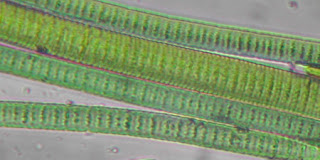It almost sounds like the plot of a sci-fi thriller: A beautiful but deadly family of blue-green algae strong-arms other freshwater microorganisms into becoming their slaves, enabling them to take control of the water and threaten health the world over.
These dastardly cyanobacteria algae - the bullies of the freshwater playground - are no fictional characters. In a paper published online on August 12 in the journal Current Biology, a researcher at the Hebrew University (HU) of Jerusalem describes how they out-muscle their competition and proliferate dangerously, causing international concern due to their detrimental impact on water quality.
By shedding light on how the algae operate, 32-year-old Ph.D. student Yehonatan Bar-Yosef's research can help water experts find out how to outmaneuver the algae and assure safe drinking water for millions of humans and animals.
Current strategy may need re-thinking
Back in 1994, when Bar-Yosef was still in high school, an enormous bloom of these toxic bacteria was found in Lake Kinneret, also known as the Sea of Galilee. As much of Israel's water supply is pumped from the Kinneret, this discovery was alarming. At the Alexander Silberman Institute of Life Sciences at HU, Prof. Aaron Kaplan began delving into the mystery.
Ten years later, Bar-Yosef came to Kaplan's lab looking for a topic for his graduate degree research. Interested in marine and microbiology, he took great interest in Kaplan's work with the blue-green alga known as Aphanizomenon.
He explains to ISRAEL21c that researchers already understood that algae blooms had something to do with the activity of enzymes used by microorganisms to scavenge inorganic phosphate compounds from their environment. His contribution was to pinpoint the source of the enzyme.
'The interesting story is that it's probably another microorganism that lives in the same environment, secreting toxins to produce this enzyme,' says Bar-Yosef. The Aphanizomena algae are not the only bacteria that thrive on the enzyme, but they know how to hog it, actually 'enslaving' other organisms to accelerate their own absorption of phosphates and form massive toxic blooms in the water.
Over the past decade, North and South America, Africa, Australia, Europe, Scandinavia and China have experienced a significant rise in cyanobacterial blooms that turn clear H2O into a foul-smelling liquid that makes people and pets sick. In response, water management authorities have attempted to reduce the flow of phosphates into fresh waters from sources including agricultural fertilizers, cattle ranching, industry and sewage. Yet Bar-Yosef's research suggests that this well-accepted strategy may need re-thinking.
Interest in findings grows
'The findings of my research show that when there is a depletion of phosphorus that's what triggers the enslavement phenomenon,' he relates. 'The next step is to find out if it's a general phenomenon and if so, whether other toxic bacteria do the same thing.'
Bar-Yosef did most of his work indoors in Jerusalem, but he also left the lab and climbed into a boat on the Kinneret every month, for two or three days at a time. He was assisted by Dr. Assaf Sukenik and Dr. Ora Hadas from the Kinneret laboratory of the Israel Institute of Limnology and Oceanography.
Bar-Yosef, who was born in Alabama and moved to Israel at age three, gave a seminar at New Jersey's Rutgers University last summer. He says he declined an invitation to a recent conference on the algae topic in Turkey because his wife is in her ninth month of pregnancy. There is wide interest in his findings.
However, he stresses that what he is able to add to the current body of knowledge is simply a new point of view leading to theoretical recommendations. Now finishing his doctorate in plant and environmental science, Bar-Yosef notes that it will now be up to others to find practical applications for his work on toxic blue-green algae. He is gearing up for a career outside academia in water-management policy." (source)








